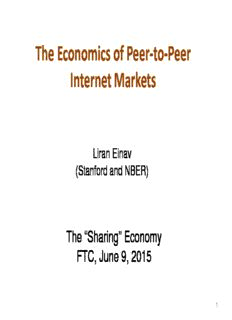
Liran Einav PDF
Preview Liran Einav
The Economics of Peer-to-Peer Internet Markets Liran Einav (Stanford and NBER) The “Sharing” Economy FTC, June 9, 2015 1 Why are we here? 2 Why are we here? 3 Why so successful? 1. Taking thin local markets and making them thick and global – E.g., eBay, Etsy, Sitter.com 2. Creating new markets – E.g., Instacart, Lyft, Taskrabbit 3. Replacing/expanding existing markets – Airbnb, Uber, Prosper and Lending Club 4 How? • Using technology to facilitate better matching of sellers and buyers – Big data, search, mobile • Cutting cost by eliminating intermediation • Cutting cost by bypassing (good or bad) regulation – “Bad” regulation? NYC cabs coming back empty from EWR – “Good” regulation? Zoning laws – “Neutral” regulation? State variation in usury laws • Shifting from high FC and low VC of dedicated resources to no FC and higher VC of non-dedicated resources – Particularly useful for markets with sharp changes in demand 5 What makes it work? 1. Market institutions – Search and matching – Pricing – Trust and reputation 2. Market evolution – Platform growth: network effects and scale economies – Changes in what gets transacted, how, and by whom – Standardization and professionalization 3. Market risks and externalities – After lunch! 6 Market Institutions and Platform Design I Matching demand and supply • Canonical problem: facilitate search and matching when people have heterogeneous preferences and the set of products is large, diverse, and unstructured – Markets can be thin in different ways: product definition (eBay), geographically (Uber), temporally (Taskrabbit) • Different kinds of frictions platforms try to solve – Search: Buyers know what they want, but need help to find it – Congestion: Buyers know what they want, but crowd the best sellers/products – Informational: Buyers don’t quite know what they want, and need informational help (on what they are likely to like, on quality, or availability) 7 Market Institutions and Platform Design II Pricing • Two distinct roles for the platform – Define the transactable unit – Provide a mechanism to establish terms of trade • Transactable unit – What is a product? Trading off between “too narrow” or “too coarse” – On Taskrabbit and oDesk – originally price by task, then by hour – In advertising – price by impression vs. click vs. conversion • Internet facilitates wider range of pricing mechanisms – Auctions, dynamic pricing, posted prices, risk scoring on lending sites – Common trade-off between more sophisticated pricing mechanisms and speed/convenience 8 Market Institutions and Platform Design III Trust and reputation • Transactions need to be “safe” for buyers and sellers – Early concern: problems of asymmetric info would be worse online where you couldn’t “inspect” goods, and payment + delivery were asynchronous • Solution: reputation and review systems – Reputation systems, grouping (oDesk’s agencies), diversification strategies (Prosper), and platform guarantees – Lots of design issues: One-sided vs. two sided reviews, Anonymous vs. non- anonymous, Who is eligible to post a review? Is it mandatory?, Review “inflation” (oDesk), Detail and granularity • Platform decision: set up institutions and let the market play out, or “take over” some of the quality verification / execution? • As we will probably hear in the second panel today, there is a lot of focus on the imperfections of reputation systems – Yet the growth of P2P markets suggests that overall the existing systems are doing quite well … 9 Market evolution Platform problem a bit different early on and later • Initially market may be inherently thin, so need to find a way for balanced growth; may be less of an issue later, where activity driven more by intensive rather than extensive margins • Key issue: where does the supply / demand elasticity come from to equilibrate the market? • E.g., on Taskrabbit: some markets work out, while others don’t. Why? Changes in what gets traded, by whom, and how: • Auction decline on eBay • Prosper and oDesk also moved toward more standardized trades once they have enough volume • As P2P markets become larger and more successful, suppliers can organize into professional “firms” – e.g. businesses on eBay, organized groups on oDesk, professional entertainers on YouTube Suggests that optimal regulation may also be different early vs later 10
Description: